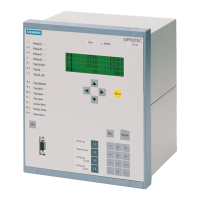Functions
2.11 Automatic Reclosure Function 79 (Optional)
SIPROTEC, 7SD80, Manual
E50417-G1140-C474-A1, Release date 09.2011
142
Initiation
Initiation of the automatic reclosing function means storing the first trip signal of a power system fault that was
generated by a protection function which operates with the automatic reclosing function, e.g. phase comparison
protection or ground fault differential protection. In case of multiple reclosing attempts, initiation therefore only
takes place once with the first trip command. This storing of the first trip signal is the prerequisite for all subse-
quent activities of the automatic reclosing function. The initiation is important if the first trip command only
appears after an action time has expired (see below under „Action times“).
The automatic reclosing function is not started if the circuit breaker has not been ready for at least one TRIP-
CLOSE-TRIP cycle at the instant of the first trip command. This can be achieved by setting parameters. For
further information, please refer to „Interrogation of Circuit-Breaker Readiness“.
Via setting parameters you can specify whether the differential protection or the overcurrent protection work
together with the automatic reclosing function or not. Furthermore, you can select whether external trip com-
mands injected via binary inputs and/or the trip commands generated by transfer trip signals/remote tripping
initiate the automatic reclosing function or not.
Those protection and monitoring functions of the device that do not respond to short circuits or similar condi-
tions (e.g. overload protection) do not initiate the automatic reclosing function because reclosing would not be
useful here. The circuit-breaker failure protection must not start the automatic reclosing function either.
Action Times
It is often desirable to prevent the readiness to reclose if the short circuit has been present for some time, e.g.
because it is assumed that the arc has burned in to such an extent that it is not likely to extinguish itself auto-
matically during the dead time. Also for reasons of selectivity (see above), faults that are usually cleared after
a time delay should not lead to reclosing.
The automatic reclosing function of the 7SD80 can be operated with or without action times (configuration pa-
rameter AR control mode, address 134, see Section 2.1.1.2). No starting signal is necessary from the pro-
tection functions or external protection devices that operate without action time. Initiation takes place as soon
as the first trip command appears.
When operating with action time, an action time is available for each reclose cycle. The action times are always
started by the general starting signal (with logic OR combination of all internal and external protection functions
which can start the automatic reclose function). If there is no trip command yet when the action time has ex-
pired, the corresponding automatic reclosing cycle cannot be executed.
For each reclosing cycle, you can specify whether or not it allows a start. Following the first general pickup, only
those action times are relevant whose cycles allow starting because the other cycles are not allowed to initiate.
By means of the action times and the permission to start the recloser (permission to be the first cycle that is
executed), it is possible to determine which reclose cycles are executed depending on the time it takes the pro-
tection function to trip.
Operating Mode of the Automatic Reclose Function
The dead times — these are the times from elimination of the fault (drop out of the trip command or signaling
via auxiliary contacts) to the initiation of the automatic close command — may vary depending on the automatic
reclosing operating mode selected when determining the functional scope and the resulting signals of the start-
ing protection functions.
In operating mode TRIP ... (with trip command ...) the dead time is set for 3-phase tripping.
In operating mode PICKUP ... (With PICKUP...) different dead times can be set for every reclosing cycle after
1-phase
, 2-phase and 3-phase faults. Here the decisive factor is the pickup diagram of the protective functions
at the instant the trip command disappears. This operating mode enables making the dead times dependent
on the type of fault in the case of 3-pole reclose cycles.

